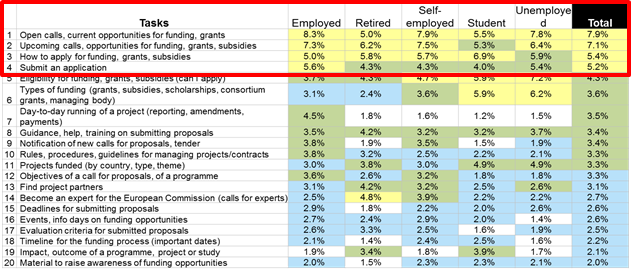Reasons for building a task-based information architecture
In 2014, following its own research and having examined findings from external experts and national public sector implementations, Europa Web Communication at DG Communication adopted a task-based approach to the architecture for the European Commission's web presence.
The principal reasons for adopting a task-based approach are as follows
- it offers significant advantages for both external and internal colleagues working on content
- it avoids making users think and potentially, hesitate
- basing site architecture on content is more efficient as it avoids content duplication and unnecessary maintenance costs
The case for a task-based architecture is reinforced by findings from Europa Web Communication's own research and analysis on the task 'Funding, tenders' (see below) which show a very strong consistency in users' top tasks, regardless of audience grouping across criteria.
- 'employment status'

- 'workplace'

- 'occupation'

- 'country of residence'

Background
Additional reasons why DTT supported a task-based approach over an audience-based approach are outlined below.
Users find it difficult to identify clearly with pre-defined audience groupings - causing them to hesitate or be confused
- not all users will interpret the groupings in the same way
- some users will feel they belong to different groups
- there may be a difference between who I think I am, and who the site or organisation thinks I am
- my audience profile is not the reason I am on your website - having to identify as belonging to one of your possible audiences causes ‘cognitive effort and user anxiety’ (see NNG's Audience-based navigation)
- users’ needs change between visits - depending on their current situation and task: i.e., Today, I have a question as a private citizen, tomorrow as a business owner, …
- users may miss or ignore relevant information if it is identified as “only for a specific audience” - they may even conclude that the information they need is not available if it is not in the audience they identify with
- users may be confused if content is identified under an audience grouping, does this mean it is FOR or ABOUT this audience?
- users may get the feeling that they are not getting the complete information about a certain subject
- “forcing people to self-identify creates an additional step and takes people out of their task mindset"
Problems with audience-based approach for editors and other internal teams:
- trouble in defining the right groupings
- creating duplicate and overlapping content, if the same content is needed or useful for different groups
- which leads to the need to create and maintain larger volumes of content, creating increased risks and reduced efficiencies in managing the content
References
- 'Hey, you there': the trouble with audience-based navigation
Cath Richardson, Inside GOV.UK, 18.07.14.
https://insidegovuk.blog.gov.uk/2014/07/18/hey-you-there-the-trouble-with-audience-based-navigation/
- Audience-Based navigation: 5 Reasons to Avoid It
Katie Sherwin, Nielsen Norman Group, 07.09.15
https://www.nngroup.com/articles/audience-based-navigation/
- Why audience navigation usually doesn't work
Gerry McGovern, 29.01.12
http://www.gerrymcgovern.com/new-thinking/why-audience-navigation-usually- doesn%E2%80%99t-work
Contact and support
Need further assistance on this topic? Please contact the team in charge of Europa Domain Management (EU Login required)
